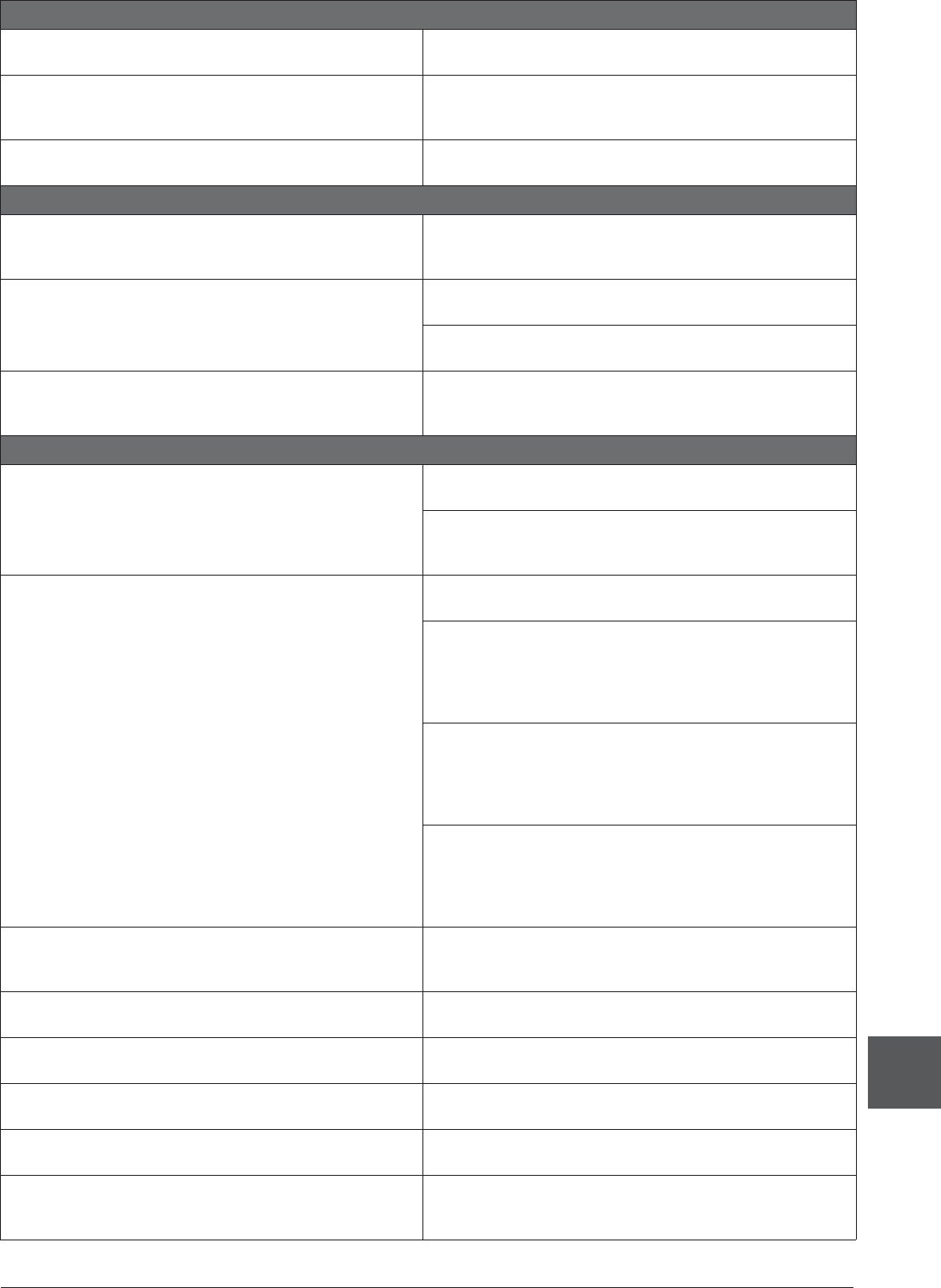
CVP-509/505/503/501 Owner’s Manual 121
Troubleshooting
Voice
The Voice selected from the Voice Selection display does not
sound.
Check whether or not the selected part is turned on (page 39).
A strange “flanging” or “doubling” sound occurs. The sound is
slightly different each time the keys are played.
The RIGHT 1 and RIGHT 2 parts are set to “ON,” and both parts are
set to play the same Voice. Turn off the RIGHT 2 part or change the
Voice of one of the parts.
Some Voices will jump an octave in pitch when played in the upper
or lower registers.
This is normal. Some voices have a pitch limit which, when reached,
causes this type of pitch shift.
Style
The Style does not start even when the [START/STOP] button is
pressed.
The Rhythm channel of the selected Style may not contain any data.
Turn the [ACMP ON/OFF] button on and play left-hand section on the
keyboard to sound the accompaniment part of the Style.
Only the rhythm channel plays. Make sure the Auto Accompaniment function is turned on; press the
[ACMP ON/OFF] button.
You may be playing keys in the right hand range of the keyboard.
Make sure to play keys in the chord range of the keyboard.
Styles in a USB storage device cannot be selected. If the size of the Style data is large (about 120 KB or greater), the
Style cannot be selected because the data is too large to be ready by
the instrument.
Song
Songs cannot be selected. This may be because the language settings have been changed. Set
the appropriate language for the Song file name (page 17).
If the size of the Song data is large (about 300 KB or greater), the
Song cannot be selected because the data is too large to be read by
the instrument.
Song playback does not start. The Song has been stopped at the end of the Song data. Return to
the beginning of the Song by pressing the SONG [STOP] button.
In the case a Song to which write-protect has been applied (“Prot. 2
Edit” is shown at the upper left of the Song name), the original file
may not be in the same folder. It cannot be played back unless the
original file (showing “Prot.2 Orig” at the upper left of the Song name)
is in the same folder.
In case of a Song to which write-protect has been applied (“Prot. 2
Edit” is shown at the upper left of the Song name), the original file
name may have been changed. Rename the file with the original file
name (so that “Prot.2 Orig” is shown at the upper left of the Song
name).
In case of a Song to which write-protect has been applied (“Prot. 2
Edit” is shown at the upper left of the Song name), the file icon may
have been changed. Songs to which write-protect has been applied
cannot be played back when the file icon of the original has been
changed.
Song playback stops before the Song is finished. The Guide function is turned on. (In this case, playback is “waiting” for
the correct key to be played.) Press the [GUIDE] button to turn off the
guide function.
The measure number is different from that of the score in the Song
Position display, shown by pressing the [REW]/[FF] buttons.
This happens when playing back music data for which a specific, fixed
tempo is set.
When playing back a Song, some channels do not play. Playback of these channels may be set to “OFF.” Turn playback ON for
those channels that are set to “OFF” (page 64).
The Guide lamps do not light during Song playback, even after
pressing the [GUIDE] button.
Any notes outside of the 88-key range cannot be indicated by the
Guide lamps.
The Guide lamps light an octave or two lower/higher than the actual
pitch.
The Guide lamps sometimes light an octave or two lower/higher than
the actual pitch depending on the selected Voice.
The tempo, beat, measure and music notation is not displayed cor-
rectly.
Some Song data for the instrument has been recorded with special
“free tempo” settings. For such Song data, the tempo, beat, measure
and music notation will not be displayed correctly.


















